Frederic Sala
LiveResearchBench: A Live Benchmark for User-Centric Deep Research in the Wild
Oct 16, 2025Abstract:Deep research -- producing comprehensive, citation-grounded reports by searching and synthesizing information from hundreds of live web sources -- marks an important frontier for agentic systems. To rigorously evaluate this ability, four principles are essential: tasks should be (1) user-centric, reflecting realistic information needs, (2) dynamic, requiring up-to-date information beyond parametric knowledge, (3) unambiguous, ensuring consistent interpretation across users, and (4) multi-faceted and search-intensive, requiring search over numerous web sources and in-depth analysis. Existing benchmarks fall short of these principles, often focusing on narrow domains or posing ambiguous questions that hinder fair comparison. Guided by these principles, we introduce LiveResearchBench, a benchmark of 100 expert-curated tasks spanning daily life, enterprise, and academia, each requiring extensive, dynamic, real-time web search and synthesis. Built with over 1,500 hours of human labor, LiveResearchBench provides a rigorous basis for systematic evaluation. To evaluate citation-grounded long-form reports, we introduce DeepEval, a comprehensive suite covering both content- and report-level quality, including coverage, presentation, citation accuracy and association, consistency and depth of analysis. DeepEval integrates four complementary evaluation protocols, each designed to ensure stable assessment and high agreement with human judgments. Using LiveResearchBench and DeepEval, we conduct a comprehensive evaluation of 17 frontier deep research systems, including single-agent web search, single-agent deep research, and multi-agent systems. Our analysis reveals current strengths, recurring failure modes, and key system components needed to advance reliable, insightful deep research.
Test-time Scaling Techniques in Theoretical Physics -- A Comparison of Methods on the TPBench Dataset
Jun 25, 2025Abstract:Large language models (LLMs) have shown strong capabilities in complex reasoning, and test-time scaling techniques can enhance their performance with comparably low cost. Many of these methods have been developed and evaluated on mathematical reasoning benchmarks such as AIME. This paper investigates whether the lessons learned from these benchmarks generalize to the domain of advanced theoretical physics. We evaluate a range of common test-time scaling methods on the TPBench physics dataset and compare their effectiveness with results on AIME. To better leverage the structure of physics problems, we develop a novel, symbolic weak-verifier framework to improve parallel scaling results. Our empirical results demonstrate that this method significantly outperforms existing test-time scaling approaches on TPBench. We also evaluate our method on AIME, confirming its effectiveness in solving advanced mathematical problems. Our findings highlight the power of step-wise symbolic verification for tackling complex scientific problems.
Time To Impeach LLM-as-a-Judge: Programs are the Future of Evaluation
Jun 12, 2025Abstract:Large language models (LLMs) are widely used to evaluate the quality of LLM generations and responses, but this leads to significant challenges: high API costs, uncertain reliability, inflexible pipelines, and inherent biases. To address these, we introduce PAJAMA (Program-As-a-Judge for Automated Model Assessment), a new alternative that uses LLMs to synthesize executable judging programs instead of directly scoring responses. These synthesized programs can be stored and run locally, costing orders of magnitude less while providing interpretable, and auditable judging logic that can be easily adapted. Program-based judges mitigate biases, improving judgment consistency by 15.83% and reducing biased responses by 23.7% on average compared to a Qwen2.5-14B-based LLM-as-a-judge. When program judgments are distilled into a model, PAJAMA outperforms LLM-as-a-judge on the challenging CHAT-HARD subset of RewardBench, outperforming metrics by 2.19% on Prometheus and 8.67% on the JudgeLM dataset, all at three orders of magnitude lower cost.
Beyond Accuracy: Dissecting Mathematical Reasoning for LLMs Under Reinforcement Learning
Jun 05, 2025Abstract:Reinforcement learning (RL) has become the dominant paradigm for endowing language models with advanced reasoning capabilities. Despite the substantial empirical gains demonstrated by RL-based training methods like GRPO, a granular understanding of their advantages is still lacking. To address this gap, we introduce a fine-grained analytic framework to dissect the impact of RL on reasoning. Our framework specifically investigates key elements that have been hypothesized to benefit from RL training: (1) plan-following and execution, (2) problem decomposition, and (3) improved reasoning and knowledge utilization. Using this framework, we gain insights beyond mere accuracy. For instance, providing models with explicit step-by-step plans surprisingly degrades performance on the most challenging benchmarks, yet RL-tuned models exhibit greater robustness, experiencing markedly smaller performance drops than their base counterparts. This suggests that RL may not primarily enhance the execution of external plans but rather empower models to formulate and follow internal strategies better suited to their reasoning processes. Conversely, we observe that RL enhances the model's capacity to integrate provided knowledge into its reasoning process, leading to performance improvements across diverse tasks. We also study difficulty, showing improved training by developing new ways to exploit hard problems. Our findings lay a foundation for more principled training and evaluation of reasoning models.
R&B: Domain Regrouping and Data Mixture Balancing for Efficient Foundation Model Training
May 01, 2025
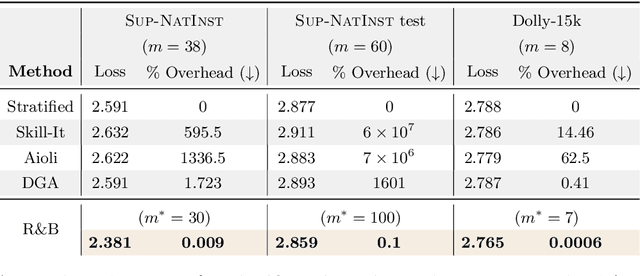
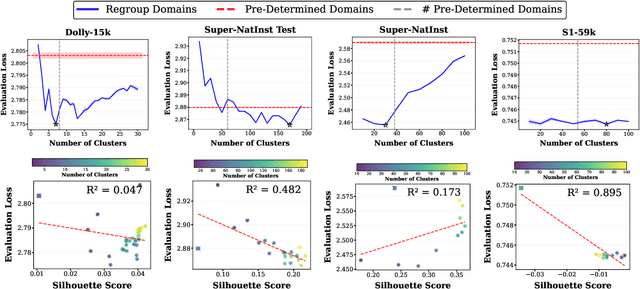
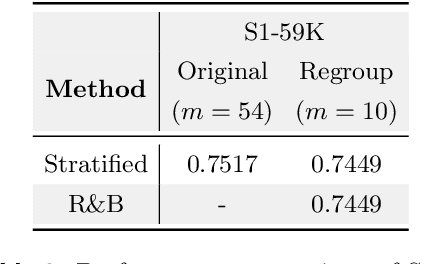
Abstract:Data mixing strategies have successfully reduced the costs involved in training language models. While promising, such methods suffer from two flaws. First, they rely on predetermined data domains (e.g., data sources, task types), which may fail to capture critical semantic nuances, leaving performance on the table. Second, these methods scale with the number of domains in a computationally prohibitive way. We address these challenges via R&B, a framework that re-partitions training data based on semantic similarity (Regroup) to create finer-grained domains, and efficiently optimizes the data composition (Balance) by leveraging a Gram matrix induced by domain gradients obtained throughout training. Unlike prior works, it removes the need for additional compute to obtain evaluation information such as losses or gradients. We analyze this technique under standard regularity conditions and provide theoretical insights that justify R&B's effectiveness compared to non-adaptive mixing approaches. Empirically, we demonstrate the effectiveness of R&B on five diverse datasets ranging from natural language to reasoning and multimodal tasks. With as little as 0.01% additional compute overhead, R&B matches or exceeds the performance of state-of-the-art data mixing strategies.
COSMOS: Predictable and Cost-Effective Adaptation of LLMs
Apr 30, 2025Abstract:Large language models (LLMs) achieve remarkable performance across numerous tasks by using a diverse array of adaptation strategies. However, optimally selecting a model and adaptation strategy under resource constraints is challenging and often requires extensive experimentation. We investigate whether it is possible to accurately predict both performance and cost without expensive trials. We formalize the strategy selection problem for LLMs and introduce COSMOS, a unified prediction framework that efficiently estimates adaptation outcomes at minimal cost. We instantiate and study the capability of our framework via a pair of powerful predictors: embedding-augmented lightweight proxy models to predict fine-tuning performance, and low-sample scaling laws to forecast retrieval-augmented in-context learning. Extensive evaluation across eight representative benchmarks demonstrates that COSMOS achieves high prediction accuracy while reducing computational costs by 92.72% on average, and up to 98.71% in resource-intensive scenarios. Our results show that efficient prediction of adaptation outcomes is not only feasible but can substantially reduce the computational overhead of LLM deployment while maintaining performance standards.
TARDIS: Mitigating Temporal Misalignment via Representation Steering
Mar 25, 2025Abstract:Language models often struggle with temporal misalignment, performance degradation caused by shifts in the temporal distribution of data. Continuously updating models to avoid degradation is expensive. Can models be adapted without updating model weights? We present TARDIS, an unsupervised representation editing method that addresses this challenge. TARDIS extracts steering vectors from unlabeled data and adjusts the model's representations to better align with the target time period's distribution. Our experiments reveal that TARDIS enhances downstream task performance without the need for fine-tuning, can mitigate temporal misalignment even when exact target time period data is unavailable, and remains efficient even when the temporal information of the target data points is unknown at inference time.
Personalize Your LLM: Fake it then Align it
Mar 05, 2025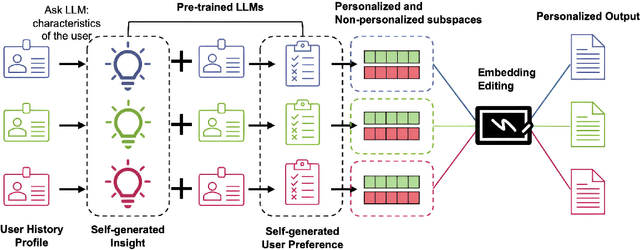

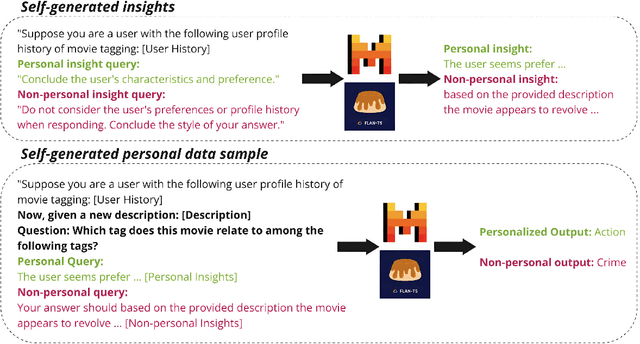

Abstract:Personalizing large language models (LLMs) is essential for delivering tailored interactions that improve user experience. Many existing personalization methods require fine-tuning LLMs for each user, rendering them prohibitively expensive for widespread adoption. Although retrieval-based approaches offer a more compute-efficient alternative, they still depend on large, high-quality datasets that are not consistently available for all users. To address this challenge, we propose CHAMELEON, a scalable and efficient personalization approach that uses (1) self-generated personal preference data and (2) representation editing to enable quick and cost-effective personalization. Our experiments on various tasks, including those from the LaMP personalization benchmark, show that CHAMELEON efficiently adapts models to personal preferences, improving instruction-tuned models and outperforms two personalization baselines by an average of 40% across two model architectures.
Tabby: Tabular Data Synthesis with Language Models
Mar 04, 2025Abstract:While advances in large language models (LLMs) have greatly improved the quality of synthetic text data in recent years, synthesizing tabular data has received relatively less attention. We address this disparity with Tabby, a simple but powerful post-training modification to the standard Transformer language model architecture, enabling its use for tabular dataset synthesis. Tabby enables the representation of differences across columns using Gated Mixture-of-Experts, with column-specific sets of parameters. Empirically, Tabby results in data quality near or equal to that of real data. By pairing our novel LLM table training technique, Plain, with Tabby, we observe up to a 44% improvement in quality over previous methods. We also show that Tabby extends beyond tables to more general structured data, reaching parity with real data on a nested JSON dataset as well.
Theoretical Physics Benchmark (TPBench) -- a Dataset and Study of AI Reasoning Capabilities in Theoretical Physics
Feb 19, 2025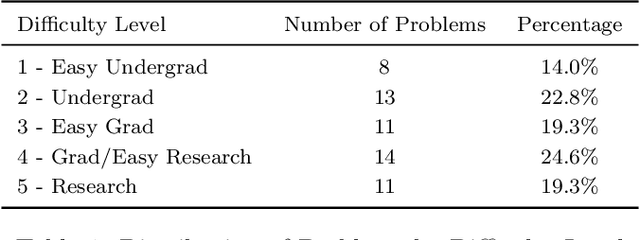
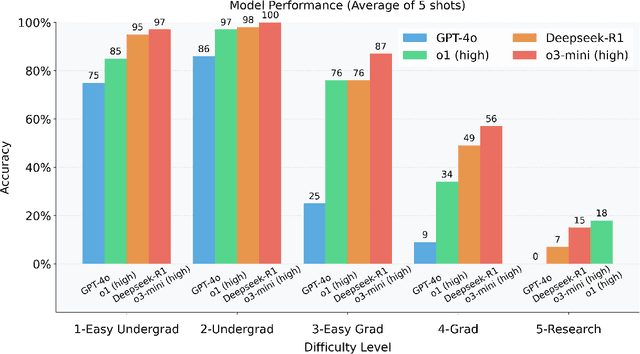

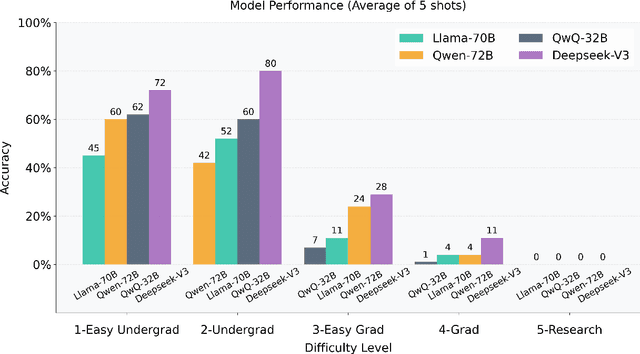
Abstract:We introduce a benchmark to evaluate the capability of AI to solve problems in theoretical physics, focusing on high-energy theory and cosmology. The first iteration of our benchmark consists of 57 problems of varying difficulty, from undergraduate to research level. These problems are novel in the sense that they do not come from public problem collections. We evaluate our data set on various open and closed language models, including o3-mini, o1, DeepSeek-R1, GPT-4o and versions of Llama and Qwen. While we find impressive progress in model performance with the most recent models, our research-level difficulty problems are mostly unsolved. We address challenges of auto-verifiability and grading, and discuss common failure modes. While currently state-of-the art models are still of limited use for researchers, our results show that AI assisted theoretical physics research may become possible in the near future. We discuss the main obstacles towards this goal and possible strategies to overcome them. The public problems and solutions, results for various models, and updates to the data set and score distribution, are available on the website of the dataset tpbench.org.
 Add to Chrome
Add to Chrome Add to Firefox
Add to Firefox Add to Edge
Add to Edge